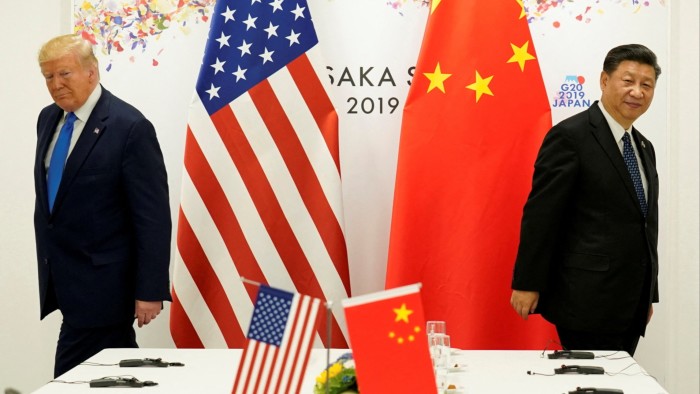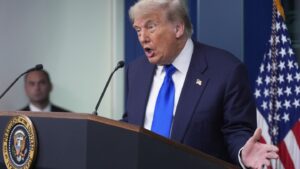
China has expressed strong disapproval of the recent trade agreement between the United States and Vietnam, raising concerns in Beijing about President Donald Trump’s strategic use of tariff negotiations with third countries to hinder its export capabilities. The agreement, announced on Wednesday, reduces tariffs on Vietnamese exports from a potential 46 percent to 20 percent but maintains a 40 percent levy on “trans-shipping” goods, a move widely interpreted as targeting Chinese re-exports to the US.
This development follows a similar deal between the US and the UK in May, which included stringent security requirements for steel and pharmaceuticals, measures perceived as efforts to exclude China from British supply chains. China’s commerce ministry responded on Thursday, stating it was “conducting an assessment” of the US-Vietnam trade deal and firmly opposing any agreements made at the expense of China’s interests.
“We firmly oppose any party striking a deal at the expense of China’s interests,” the ministry stated, adding, “If such a situation arises, China will take resolute countermeasures to safeguard its legitimate rights and interests.”
Strategic Implications of the US-Vietnam Deal
The announcement comes as numerous countries race to finalize trade deals with the US before the July 9 deadline, when Trump’s suspended “reciprocal” tariffs are set to take effect. Vietnam, heavily reliant on trade, had a significant incentive to act swiftly, with the US accounting for 30 percent of its exports. However, the final tariffs and additional levy on trans-shipping indicate the substantial cost for Hanoi to secure the agreement, according to analysts.
Julien Chaisse, an international economic law expert at the City University of Hong Kong, remarked, “The new US-Vietnam deal is not just about trade; it is clearly aimed at China… it is meant to block the flow of Chinese goods that often move through Vietnam to dodge existing US duties.”
“This fits a much wider trend: the US is lining up bilateral deals with countries near China to tighten economic co-operation and, at the same time, [make] it harder for Beijing to stretch its supply chain influence,” Chaisse added.
Regional and Global Repercussions
Many Southeast Asian nations have thrived during the US-China trade war by offering alternative manufacturing and export hubs for Chinese companies seeking to evade US tariffs. This strategy, known as “China plus one,” has led to significant trade surpluses with the US. However, the US-Vietnam deal signals a potential shift in this dynamic.
Mark Williams and Gareth Leather, economists at Capital Economics, noted, “The key lesson for other countries from this deal, and that agreed previously by the UK, is that they will be expected to curtail some trade with China. That will be seen as a provocation in Beijing, particularly if similar conditions are included in any other deals agreed over coming days.”
Analysts caution that agreements perceived as threatening China’s interests could jeopardize ongoing US-China trade negotiations. Despite a recent tariff truce claimed by Trump, tensions persist over issues like Chinese restrictions on rare-earth exports and US controls on advanced technology exports.
“This could certainly lead to a renewed escalation of US-China trade tensions if the US insists on very stringent restrictions by third parties on imports from China,” warned Frederic Neumann, chief Asia economist at HSBC.
Challenges and Uncertainties Ahead
For Vietnam, the deal’s success hinges on the enforcement of the 40 percent trans-shipment levy. Trans-shipment is notoriously difficult to trace, and the Trump administration has not clarified its definition of the practice, despite prioritizing the issue in trade talks with Vietnam and other Southeast Asian countries.
Brian Wong, a professor at Hong Kong University, highlighted the challenges, stating, “The devil lies in the details of enforcement as opposed to the agreements.” He suggested that Beijing’s vocal opposition might be largely “performative.”
Adam Sitkoff, executive director of the American Chamber of Commerce in Hanoi, emphasized the need for clarity on the deal’s specifics, including whether the 20 percent tariff is final or additional to existing levies, and which products are subject to the 40 percent charge. “Assessing the pros and cons of the deal is difficult without seeing further details about what the tariffs actually mean,” he said.
“Do the 40 percent tariffs on ‘trans-shipped’ goods apply to any product that contains content from another nation? The answers to these questions can be the difference between celebrating or crying,” Sitkoff concluded.
As the July 9 deadline approaches, the global trade landscape remains in flux, with potential implications for US-China relations and the broader geopolitical balance.






